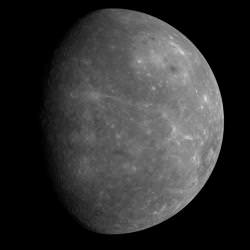Even though spacecraft have visited Mercury in the past, the same hemisphere was always in sunlight for every encounter. One side was photographed, and the other side was a complete and total mystery. There could be a big smiley face there, and we’d never know it. Well, the mystery’s over. MESSENGER flew past Mercury on January 14th, 2008, and revealed the planet’s hidden side… mostly.
Mariner 10 was the first spacecraft to zip past the planet Mercury, making three flybys in 1974 and 1975. Because the same hemisphere was in sunlight, the spacecraft was only able to image half the planet.
On January 14th, 2008, NASA’s MESSENGER spacecraft captured this image of Mercury when it was about 27,000 km (17,000 miles) away from the planet. During this flyby, it filled in about half of the hemisphere missed by Mariner 10. So that means that there are still some parts hidden – waiting to be revealed in future flybys.
And so, did it see a smiley face? Nope. The hidden hemisphere was pretty much like the rest of Mercury revealed so far: craters, ridges, bright and dark regions. At the upper right is the giant Caloris basin; its western regions haven’t been seen by spacecraft before.
If you’re hoping for more photos, don’t worry. This is just a quick black-and-white image captured by MESSENGER. NASA is planning to release more detailed images, including colour photographs over the next few days, so stay tuned.
We’ll keep posting them as they’re released.
Original Source: MESSENGER News Release


Hi. Just to let you know this is not our first look at Mercury’s side not seen by Marianer 10. There were some radar images made showing a crater that’s the twin of Tycho a few years back. This was in 2003. It was made with the Arecibo radar dish. The year before there was another image of Mercury unphotographed side. There were also some new information last year on the unseen side.
Speaking of images. Does anyone know why JAXA is so stingy with the resolution of their downloadable Lunar orbiter photos? I’m sure their program is publicly funded as is NASA. But NASA truly rules when it comes to image quality and generosity of downloadable kilobite content. Come on Japan, get with it! You’re embarassing yourselves. You have spectacular photos of the Earth from the Moon to share, why not let the world see them in all their glory? Give the masses something to contemplate other than their navels!
Nasa is the most valuable agency in human history ,it tries to reveal the unknown about our univers. At the same time humans tries to distroy their unique Earth .
At the 2006 NCRAL convention in Appleton WI, my favorite observing buddy Duane and I got to sit next to Ron Dantowitz who imaged Mercury 40,000 times, went through each image WITHOUT USING A COMPUTER PROGRAM, and selected the best 20 percent to get an image of a large crater that no one else had ever seen before. I eagerly await images of that feature, which Ron will get to name.